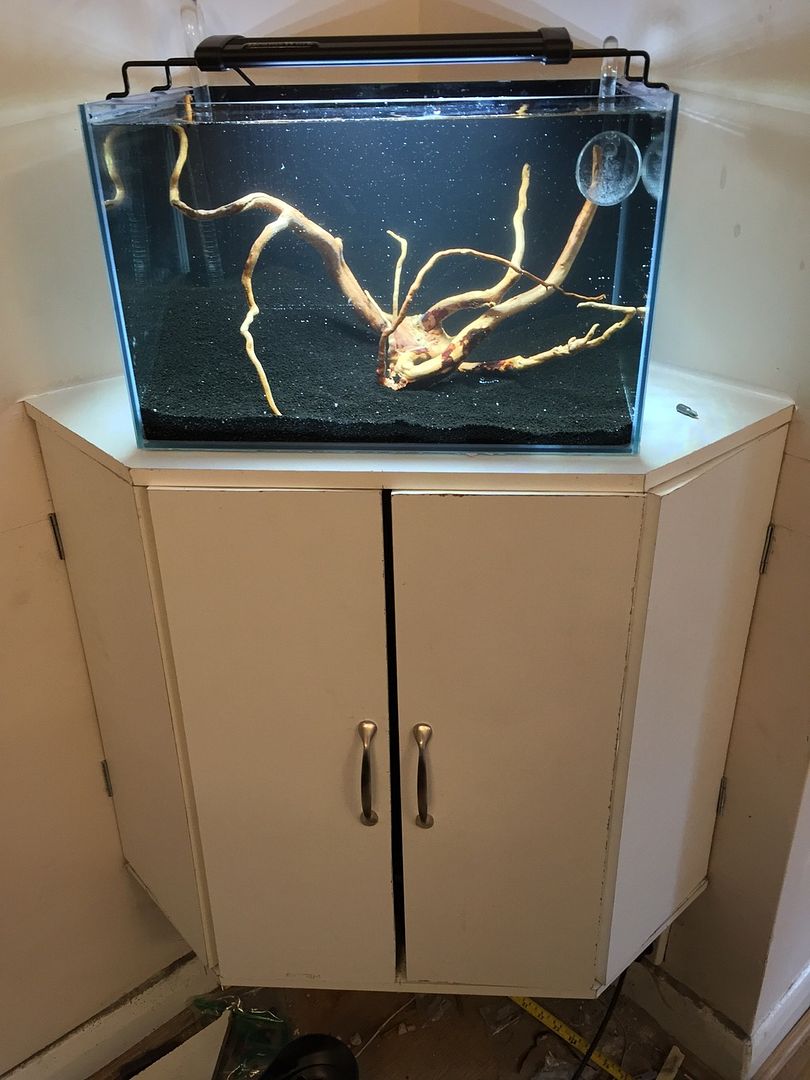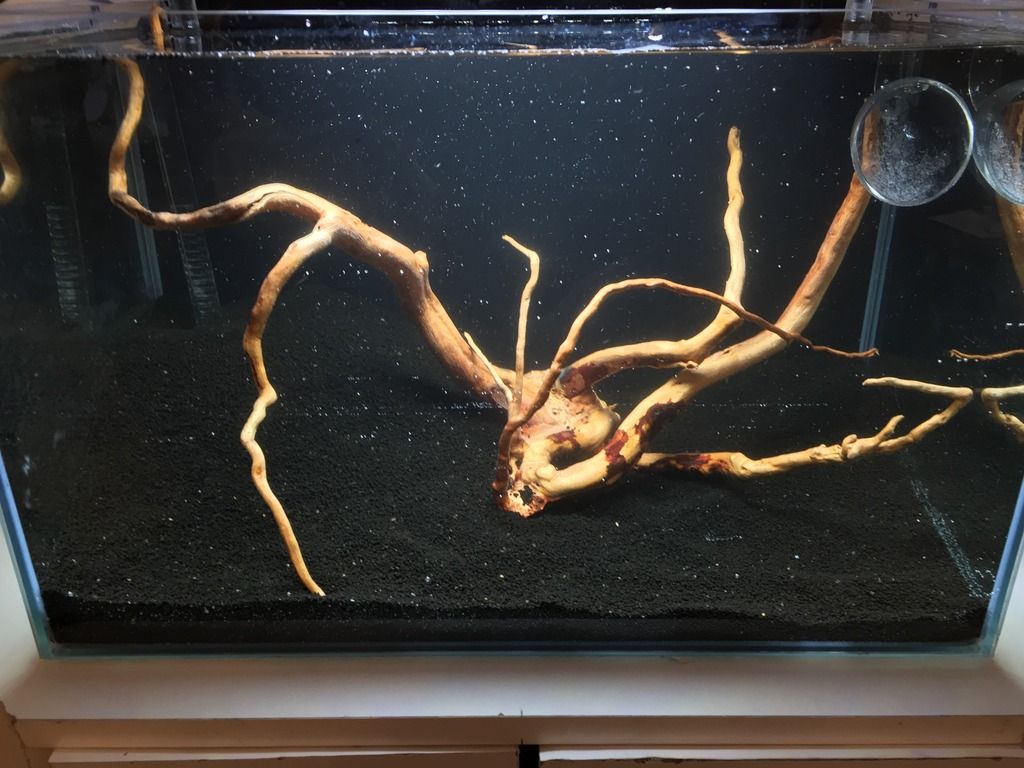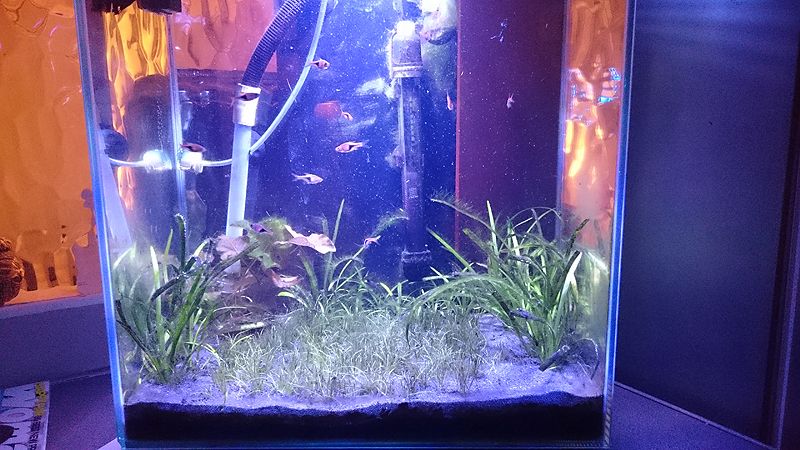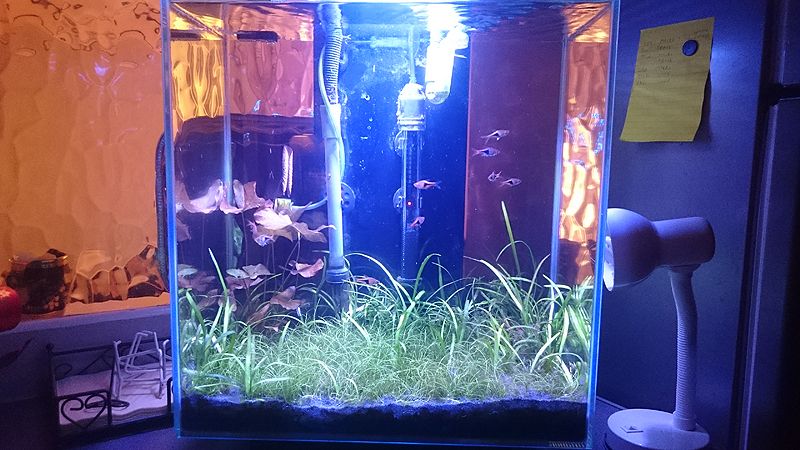My freshwater planted nano tank project
Discussion
otolith said:
I am wondering slightly whether the rain water was a good idea - you've probably introduced a lot of algal species you wouldn't have got in tap water.
Yes, I might not stick with the rainwater. I might use a mixture of tapwater and shop-bought R/O water instead. Hopefully I can get the plants growing well enough to squeeze out any algae.Bit of an update, although not a hugely exciting one.
It certainly is turning into a slow-burn project, made all the slower by the discovery of a faulty CO2 regulator; it took me a while to figure out that it wasn't me being a fool. I will be sending it back, and will have to wait for a replacement.
The filter and inline heater are all plumbed in and have been running nicely for a couple of weeks or more. The greenness of the water has reduced considerably. I've done some measurements, and will want to use a ratio of about one part tapwater to three parts rainwater, giving a KH of about 4 degrees and a similar GH.
This weekend, time permitting, I plan to drain down and do a couple of jobs that require the tank to be dry and moveable. Firstly, I want to spray the outside of the back glass. I'm going to use black 'Plastidip', which I'm hoping will give a nice textureless finish that you won't be aware of. And it'll be peelable if I change my mind.
Secondly, I want to make a support for a lid. Some kind of transparent plastic runners or something like that, then I'll have a two-piece lid that can slide back. I might drill lots of holes in the lid so that there is reasonable gas exchange.
I will also tip the bag of aquarium soil into the bottom and decide whether I've got enough. I've gone for a very fine sand-like soil with grains about a millimetre or two, which should enhance the sense of scale. Then I'll refill and wait for my regulator to come back so that I can start experimenting with the CO2.
I am planning to hand in my notice at work this afternoon and will probably take a sabbatical of a few months to decide what I want to do next in life - fed up with software development. So the tank might get a bit more attention - really hoping they offer gardening leave instead of making me work out my notice, but I think that's optimistic.
Edited to add: Pondering a Raspberry Pi Zero as a programmable temperature controller. Could then let the temperature drop a degree or two at night. But then, I did say I was fed up with software development...
It certainly is turning into a slow-burn project, made all the slower by the discovery of a faulty CO2 regulator; it took me a while to figure out that it wasn't me being a fool. I will be sending it back, and will have to wait for a replacement.
The filter and inline heater are all plumbed in and have been running nicely for a couple of weeks or more. The greenness of the water has reduced considerably. I've done some measurements, and will want to use a ratio of about one part tapwater to three parts rainwater, giving a KH of about 4 degrees and a similar GH.
This weekend, time permitting, I plan to drain down and do a couple of jobs that require the tank to be dry and moveable. Firstly, I want to spray the outside of the back glass. I'm going to use black 'Plastidip', which I'm hoping will give a nice textureless finish that you won't be aware of. And it'll be peelable if I change my mind.
Secondly, I want to make a support for a lid. Some kind of transparent plastic runners or something like that, then I'll have a two-piece lid that can slide back. I might drill lots of holes in the lid so that there is reasonable gas exchange.
I will also tip the bag of aquarium soil into the bottom and decide whether I've got enough. I've gone for a very fine sand-like soil with grains about a millimetre or two, which should enhance the sense of scale. Then I'll refill and wait for my regulator to come back so that I can start experimenting with the CO2.
I am planning to hand in my notice at work this afternoon and will probably take a sabbatical of a few months to decide what I want to do next in life - fed up with software development. So the tank might get a bit more attention - really hoping they offer gardening leave instead of making me work out my notice, but I think that's optimistic.
Edited to add: Pondering a Raspberry Pi Zero as a programmable temperature controller. Could then let the temperature drop a degree or two at night. But then, I did say I was fed up with software development...

Edited by Dr Mike Oxgreen on Thursday 26th November 13:54
I always paint the back of my tanks black, tbh any old oil based paint will work, brush marks not an issue as you paint the outside of the tank and light/view it from the inside the glass so it will always look nice and smooth. Assuming the back of the tank is against the wall. If you want to remove it, it just comes off easily with either sticky tape or a razor blade.
A slightly more interesting update...
I have painted the back glass, added the substrate, bought a nice piece of dead wood, and refilled. It's looking a bit bubbly at the moment, and it all looks a bit black, but I've made some progress. I've even finished the cabinet, the shonkiness of which will mostly be hidden behind a sofa.


I have painted the back glass, added the substrate, bought a nice piece of dead wood, and refilled. It's looking a bit bubbly at the moment, and it all looks a bit black, but I've made some progress. I've even finished the cabinet, the shonkiness of which will mostly be hidden behind a sofa.


Edited by Dr Mike Oxgreen on Sunday 29th November 14:12
That background looks great! I've got fine black gravel and I'm now tempted to give the glass a coat of black after seeing this, and the fact I never got around to sorting any background whatsoever... I take it the Plastidip stuff was easy to apply, straight out of the can onto clean glass, right?
Dead wood fits in well, looking forward to seeing updates with some greenery going in
Dead wood fits in well, looking forward to seeing updates with some greenery going in

Yes, the Plastidip was easy, but it runs badly so I'd recommend spraying onto a horizontal surface. The instructions imply that you should use moderately heavy coats.
Time will tell whether it's tough enough. I accidentally damaged the paintwork when something dug into it, so I had to cut a section out with a knife and repaint. But that was when the paint had only just become touch-dry so it might be better now it's had some time to set properly.
Also, suction cups don't stick to it, even if you moisten them.
So it's quite good, but not without its drawbacks!
Can't wait to get the faulty regulator back so I can start experimenting with the CO2, then order my plants. The water has gone quite brown overnight, but that's to be expected and the instructions with the substrate do recommend changing the water frequently to start with.
Time will tell whether it's tough enough. I accidentally damaged the paintwork when something dug into it, so I had to cut a section out with a knife and repaint. But that was when the paint had only just become touch-dry so it might be better now it's had some time to set properly.
Also, suction cups don't stick to it, even if you moisten them.
So it's quite good, but not without its drawbacks!
Can't wait to get the faulty regulator back so I can start experimenting with the CO2, then order my plants. The water has gone quite brown overnight, but that's to be expected and the instructions with the substrate do recommend changing the water frequently to start with.
Tested the water last night.
Nitrite is way high: 5 mg/l
Nitrate is very high: 80 mg/l
Ammonia is zero.
Curious. So either:
I added about an eggcupful of my 'special' ammonium solution (see threads passim for details, or just use your imagination). Will test for ammonia this evening to see what's going on. If I can't get the ammonia level to go up then I guess my filter is already partly cycled, and I just need to wait for the population of nitrobacter to increase so that they keep the nitrite down to zero as well.
Nitrite is way high: 5 mg/l
Nitrate is very high: 80 mg/l
Ammonia is zero.
Curious. So either:
- the substrate has leached a load of nitrite and nitrate into the water, but no ammonia, or
- the substrate has leached some ammonia into the water, but my filter has already partially cycled and has already converted the ammonia into nitrite and thence into nitrate as well.
I added about an eggcupful of my 'special' ammonium solution (see threads passim for details, or just use your imagination). Will test for ammonia this evening to see what's going on. If I can't get the ammonia level to go up then I guess my filter is already partly cycled, and I just need to wait for the population of nitrobacter to increase so that they keep the nitrite down to zero as well.
After several months of low success keeping aquarium plants, I decided to give the stuff that Dr Mike Oxgreen uses a go.
26th October

6th December

There hasn't been much vertical growth but I have been pruning a lot of dead growth or leaves with too much algae on. Everything is certainly greener though.
I am getting load of hair algae, especially in the grass. I brush it everyday with a toothbrush to remove it but it keeps coming back.
I don't think that my light is adequate, hence the CFL lamp at the side which I turn on for a few hours in the evening.
26th October

6th December

There hasn't been much vertical growth but I have been pruning a lot of dead growth or leaves with too much algae on. Everything is certainly greener though.
I am getting load of hair algae, especially in the grass. I brush it everyday with a toothbrush to remove it but it keeps coming back.
I don't think that my light is adequate, hence the CFL lamp at the side which I turn on for a few hours in the evening.
Not bad growth, Galsia. I would be tempted to put lots more plants in, which will tilt the balance of competition towards the 'proper' plants and away from the algae. If you're worried about your light levels, try plants like Java Fern, Java Moss, and Anubias nana.
It would also be worth testing your water to see what your nitrate level is - it could be that you've got high-ish nitrates which are driving the algal growth. Again, more plants will help to reduce nitrate build-up, and of course water changes (but test your tapwater as well, sometimes it's surprisingly high in nitrate). You can get very simple test kits that consist of little strips that you dip in the water, and can give you several different test readings in one go - e.g. pH, nitrate, nitrite, KH, etc.
Low CO2 levels can also be the cause of algal growth. You can get liquid additives that will do a partial job of restoring the CO2 balance - that might be worth considering. Or try making a DIY yeast fermentation reactor out of a small plastic drink bottle and some tubing. There's plenty of guidance online.
My own tank is making biological progress. Last night I tested the water, and the ammonia has fallen from about 6 mg/l to about 3, and the nitrite has shot up and is now off the scale of my test strips. So the first stage of nitrification is definitely happening, which is good news.
Interestingly, the KH has dropped almost to zero and the pH has fallen from about 7.0 to about 6.5. So something (substrate?) has been acidifying the water and using up its KH buffering. I will need to keep an eye on this, and maybe do a big water change to restore the buffering and prevent a pH crash. To be fair, the instructions with the substrate do say that it's necessary to do frequent water changes at first, but I haven't bothered because there's no livestock in there and I'm more interested in getting the tank cycled. Before adding any fish (which is still at least a month or two away) I will probably buy a more accurate titration-based KH test.
The water surface has a persistent scum, and there is a bacterial film growing on the decorative wood. I'm hoping that these will disappear once everything is cycled and I've got plants growing, or indeed the shrimp will probably clean the wood up once they're introduced. For now I'm mopping up the surface scum with kitchen paper every day or two. I'm quite surprised that there's no algae, given that I have been switching the light on for a few hours each evening.
Still waiting for my repaired CO2 regulator to be returned to me, so I still haven't got any CO2 going in at the moment. I need that before adding plants. Glad that I'm happy for this to be a slow-developing project, otherwise I'd be getting frustrated!
It would also be worth testing your water to see what your nitrate level is - it could be that you've got high-ish nitrates which are driving the algal growth. Again, more plants will help to reduce nitrate build-up, and of course water changes (but test your tapwater as well, sometimes it's surprisingly high in nitrate). You can get very simple test kits that consist of little strips that you dip in the water, and can give you several different test readings in one go - e.g. pH, nitrate, nitrite, KH, etc.
Low CO2 levels can also be the cause of algal growth. You can get liquid additives that will do a partial job of restoring the CO2 balance - that might be worth considering. Or try making a DIY yeast fermentation reactor out of a small plastic drink bottle and some tubing. There's plenty of guidance online.
My own tank is making biological progress. Last night I tested the water, and the ammonia has fallen from about 6 mg/l to about 3, and the nitrite has shot up and is now off the scale of my test strips. So the first stage of nitrification is definitely happening, which is good news.
Interestingly, the KH has dropped almost to zero and the pH has fallen from about 7.0 to about 6.5. So something (substrate?) has been acidifying the water and using up its KH buffering. I will need to keep an eye on this, and maybe do a big water change to restore the buffering and prevent a pH crash. To be fair, the instructions with the substrate do say that it's necessary to do frequent water changes at first, but I haven't bothered because there's no livestock in there and I'm more interested in getting the tank cycled. Before adding any fish (which is still at least a month or two away) I will probably buy a more accurate titration-based KH test.
The water surface has a persistent scum, and there is a bacterial film growing on the decorative wood. I'm hoping that these will disappear once everything is cycled and I've got plants growing, or indeed the shrimp will probably clean the wood up once they're introduced. For now I'm mopping up the surface scum with kitchen paper every day or two. I'm quite surprised that there's no algae, given that I have been switching the light on for a few hours each evening.
Still waiting for my repaired CO2 regulator to be returned to me, so I still haven't got any CO2 going in at the moment. I need that before adding plants. Glad that I'm happy for this to be a slow-developing project, otherwise I'd be getting frustrated!
otolith said:
RE the pH instability, is it still filled with rainwater?
Not pure rainwater, no. After some experimentation I found that a ratio of 1 part tapwater to 3 parts rainwater gave me a KH and GH of about 4 degrees each, which is about what I want (or do you think that's too low?). After adding the substrate I therefore filled it with that ratio, and the KH was indeed around 4 degrees - but it has fallen since then. I haven't got a problem with low pH yet, but with a KH that barely registers on my test strips it's a potential issue.I think it's likely the substrate is leaching humic acid or something like that, which has gradually used up the KH buffering. It'll probably stop doing that after a few water changes.
After I've tested this evening, I might do a 50% water change with a 'stronger' ratio (more tapwater) to restore the KH to a more sensible level. I want to avoid a pH crash because I guess that would set back the development of my bacterial colony.
Dr Mike Oxgreen said:
Not bad growth, Galsia. I would be tempted to put lots more plants in, which will tilt the balance of competition towards the 'proper' plants and away from the algae. If you're worried about your light levels, try plants like Java Fern, Java Moss, and Anubias nana.
The plant on the left goes through sudden growth spurts and the leaves end up blocking the light which due to the design of the tank only comes through a small opening in the middle. I wouldn't mind some plants which grow to about the height of the tank but don't need constant pruning.I was interested in getting some Java Fern but I read that one of my fish isn't compatable. I can't remember which now though. I have a betta, glowlight tetras, a suckermouth catfish and amano shrimp.
Dr Mike Oxgreen said:
It would also be worth testing your water to see what your nitrate level is - it could be that you've got high-ish nitrates which are driving the algal growth. Again, more plants will help to reduce nitrate build-up, and of course water changes (but test your tapwater as well, sometimes it's surprisingly high in nitrate). You can get very simple test kits that consist of little strips that you dip in the water, and can give you several different test readings in one go - e.g. pH, nitrate, nitrite, KH, etc.
I've owned aquariums for years and I have never bothered with checking water parameters. I suppose that I should really. 
Dr Mike Oxgreen said:
Low CO2 levels can also be the cause of algal growth. You can get liquid additives that will do a partial job of restoring the CO2 balance - that might be worth considering. Or try making a DIY yeast fermentation reactor out of a small plastic drink bottle and some tubing. There's plenty of guidance online.
I have a DIY CO2 system already. The bubbles go straight to the surface and dissipate immediately so I don't know how effective it is.Gassing Station | All Creatures Great & Small | Top of Page | What's New | My Stuff



